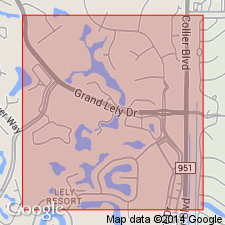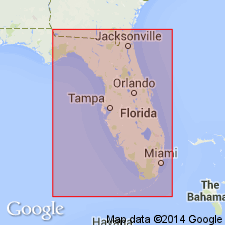
- Usage in publication:
-
- Marco Junction Formation
- Modifications:
-
- Named
- Dominant lithology:
-
- Limestone
- Dolomite
- Anhydrite
- AAPG geologic province:
-
- Florida platform
Summary:
Marco Junction Formation named and assigned to Big Cypress Group in Collier Co., southeastern FL. Consists predominantly of chalky limestone with dolomite and anhydrite beds. Dense limestone occurs at base, and thick, persistent anhydrite at top of unit. Thickness is 101 m in type well. Overlies Rattlesnake Hammock Formation (new name) of Ocean Reef Group and underlies Gordon Pass Formation (new name), also of Big Cypress. Age is Early Cretaceous (Comanchean).
Source: GNU records (USGS DDS-6; Reston GNULEX).

- Usage in publication:
-
- Marco Junction Formation*
- Modifications:
-
- Overview
- AAPG geologic province:
-
- Florida platform
Summary:
Early Cretaceous Marco Junction Formation of Big Cypress Group used following Faulkner and Applegate (1986, Gulf Coast Association of Geological Societies Transactions, v. 36, p. 83-96) and Lloyd (1991, Florida Geological Survey Information Circular 107, p. 1-62).
Source: GNU records (USGS DDS-6; Reston GNULEX).
For more information, please contact Nancy Stamm, Geologic Names Committee Secretary.
Asterisk (*) indicates published by U.S. Geological Survey authors.
"No current usage" (†) implies that a name has been abandoned or has fallen into disuse. Former usage and, if known, replacement name given in parentheses ( ).
Slash (/) indicates name conflicts with nomenclatural guidelines (CSN, 1933; ACSN, 1961, 1970; NACSN, 1983, 2005, 2021). May be explained within brackets ([ ]).

